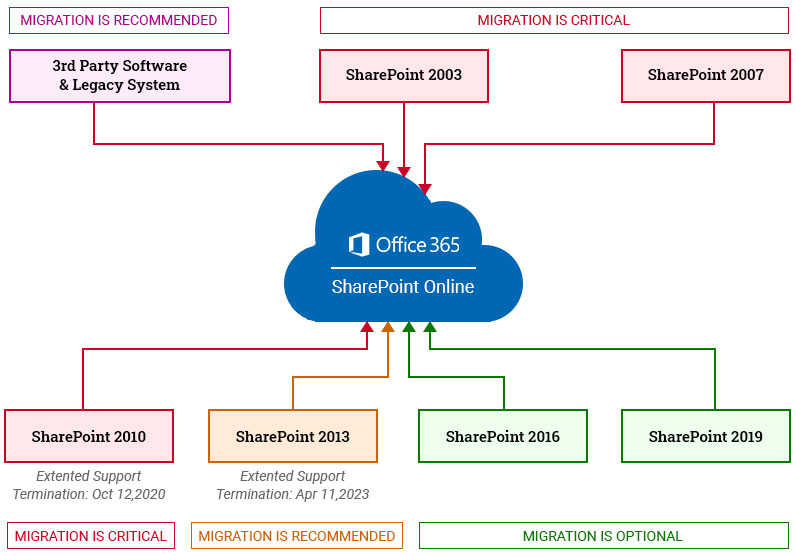Microsoft SharePoint 2010 to SharePoint Online Migration
Microsoft has announced the end-of-life support for SharePoint 2010. Those who are using on-premises SharePoint 2010 must be eager to know that what will happen after the support ends. Will the SharePoint on-premises environment stop working? If that is so, it means now is the time to upgrade your SharePoint to the top versions or migrate to SharePoint Online.
What is end-of-life support?
Every Microsoft product comes with a life cycle and during this, they get new features, bug fixes, security fixes, etc. Once the product support date ends product does not stop working but the Microsoft stops providing support services like:
- Technical support for the new problems
- Bug fixes for issues
- Security fixes
- Time zone updates
A software lifecycle typically lasts for ten years from the initial release. Microsoft SharePoint 2010 and SharePoint Server 2010 are reaching their end of support on April 13, 2021. That means there will be no further updates, patches, or fixes for the product including security patches/fixes after the above-said date.
What are the options?
Organizations who are using SharePoint server 2010 can opt to stay with SharePoint Server with a multi-staged migration to a later iteration: SharePoint 2013, 2016, or 2019. However, these versions will also have an end-of-life support date.
- SharePoint 2013 – April 11, 2023
- SharePoint 2016 – July 14, 2016
- SharePoint 2019 – To be announced.
The second option is to move to SharePoint Online as part of Office 365.

What to do now?
If you are planning to migrate or want to migrate and need a plan following points will help you for sure.
1. Plan the audit and prepare a detailed report on what needs to migrate and what not? Like, you have data that is no longer needed or inactive or you may have orphaned sites or users. Decide what is relevant to migrate.

2. Having a detailed inventory of your source environment will help you make better decisions and a more accurate assessment of the effort involved. The more information you have, the easier it will be to plan your migration. Establish an inventory with the following details.
- Site collections
- Sites
- List and libraries
- Pages
- Custom solutions
- Workflows
- Content types
- Site columns
- Permissions
- User alerts
- Retention policies
- Users and groups used.
- Large lists or libraries
- All files that have a dependency on another file using a URL
- Blocked file types
- Branding
- Any other UI customizations (JavaScript, altered menus, etc.)
3. SharePoint is all about helping people build what they need to get their work done, but that does not mean everything in your source environment will still be relevant today. Take out time to find, remove and reorganize things in your environment.
- Find and remove “orphaned users”.
- Remove empty SharePoint groups.
- Put users with explicit permissions back into groups.
- Delete any unused custom content types, site columns, and workflows.
- List sites that haven’t been accessed or modified in a while and determine whether they’re still needed.
- Documents, that have never been checked in (make sure you migrate the most recent version)
- Remove duplicate content.
- Clean up items containing too many custom permissions.
- Remove unwanted versions from your version history.
- Reorganize lists and libraries with too many columns.
- Rethink and reorganize very large lists.
Ask users to complete any pending workflow tasks.
4. Your biggest challenge for the migration is bringing change to your users. For this to be successful, you will need to make sure they know what is going on and why it’s happening.
Before you start, inform your users about:
- Expected downtime.
- The reason for the change and the value for them
- Possible changes in the environments
- URL changes
- Bookmarks
- Document references
- Excel macros, etc.
- The estimated timeline for the migration
- Find out where to get an updated status or help during the transition.
- Circulate the proposed calendar ahead of time to ensure it will not interfere with business-critical efforts.
Finalizing the SharePoint migration tools and process
For the SharePoint Migration, you can have different approaches.
a) In the “In-place SharePoint upgrade” database attach method is used. In the database-attach method, you first create and configure a SharePoint 2013 farm. Then you copy the content and service application databases from the SharePoint 2010 Products farm and then attach and upgrade the databases. This upgrades the data to the new version. Site owners can then upgrade individual site collections.
Note: This applies to the on-premises environments only.
b) Manual Migration: Manual migration means the ability to move your current SharePoint environment data to a new SharePoint environment. In the case of manual migration, the following are a few things you must consider.
You can only download and upload the files.
- You will lose the metadata of files.
- You will lose the File versioning.
- Manual migration will replace CREATED BY|MODIFIED BY as well as CREATED DATE|MODIFIED DATE with the user who is doing the migration and the date will be set when migration is done.
- Permissions will not be migrated.
c) Using code (PowerShell Scripts) : The content can also be migrated using PowerShell scripts but to use this you must have technical knowledge. Few prerequisites need to be taken care of. Metadata and permissions can also be migrated using PowerShell scripts.
d) Using Migration tools: There are many SharePoint migration tools available in the market including the free tool provided by Microsoft and it’s become difficult to choose one. The most common and widely used migration tools are Sharegate Desktop, Metalogix, and AvePoint. Developers prefer to use the Sharegate Desktop tool as it aligns with most of the critical migration requirements and has better performance in comparison to other migration tools present in the market. Depending on the type of migration you are planning, migration tools or manual migration are selected.
Customization
If you have done any customization in SharePoint On-premises, then while migrating to SharePoint you need to rebuild your customization.
Final Thoughts!
Undoubtedly, migration from SharePoint 2010 to SharePoint 2016, 2019 or cloud is a time-consuming task. It is complicated but critical for all who are still using this version. It is high time when you should start planning for migration soon to avoid later hiccups.
Successful SharePoint Migrations require a detailed strategy and careful implementation- an area in which we excel. We have a team of SharePoint and M365 experts who have experience in processing critical Migration processes. Consult with our SharePoint experts at [email protected] to know why and how migration to Microsoft SharePoint online can be beneficial to your business and how we can make your migration seamless.






